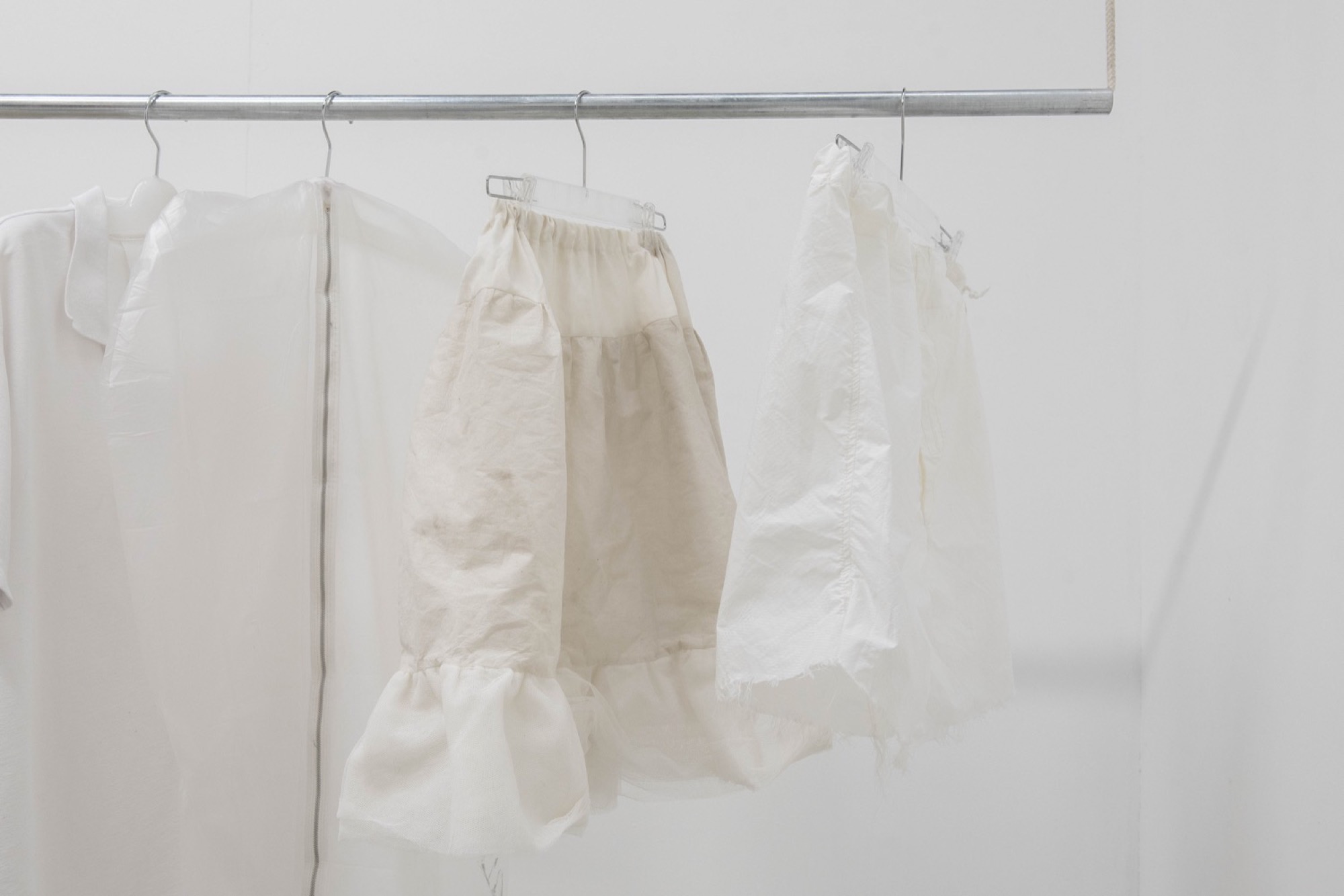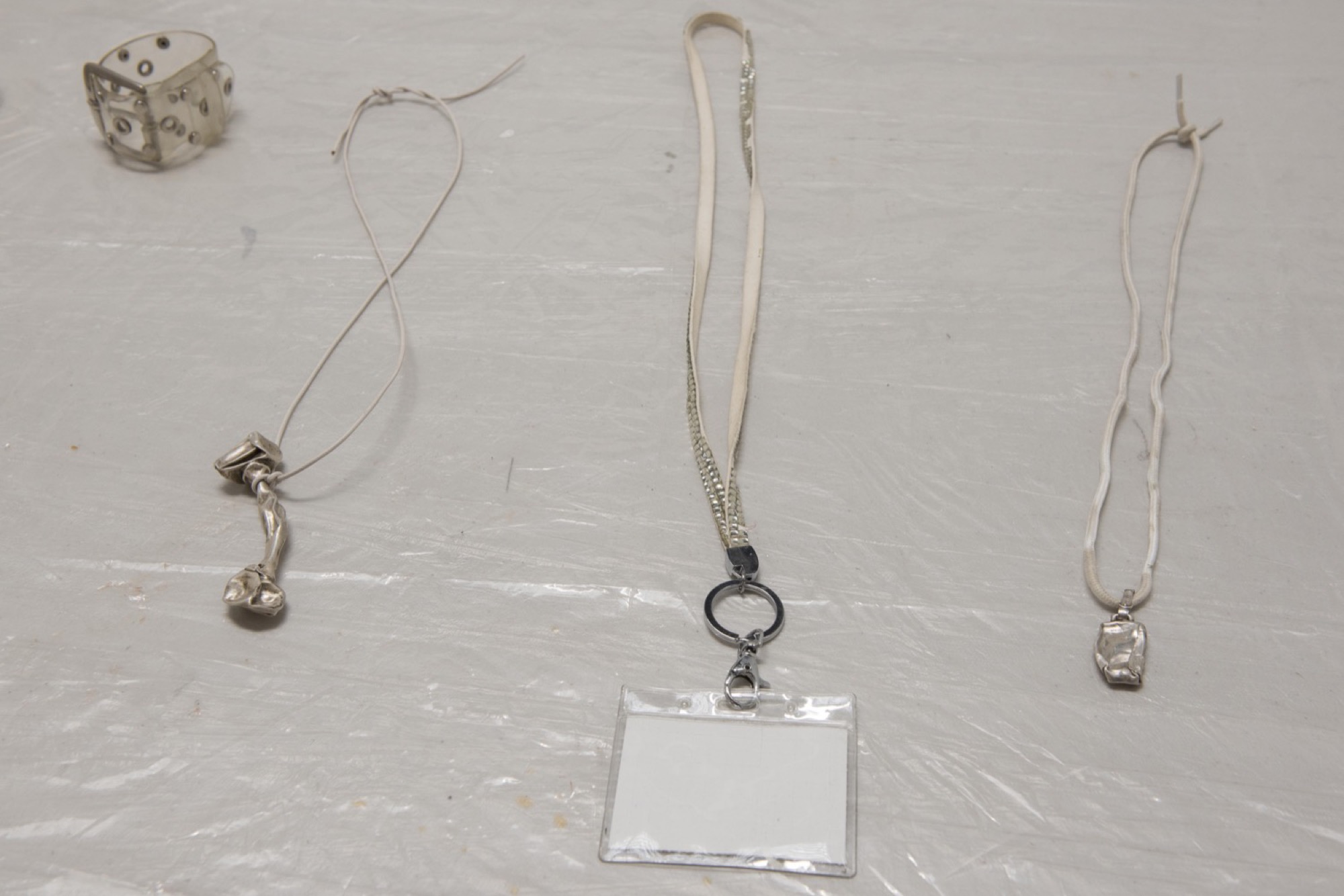Rex Veal, Summer 20/21
Audrey Schmidt
Before flower power and hippies latched onto the Peace and Love mind-altering substance, LSD was tested as a neuro-medical-military weapon along with psilocybin and other psychedelic compounds. Psychedelics first grew out of the early twentieth century’s plunge into mass manipulation, with Nazi scientists among the first to explore its psychopharmaceutical potential, followed by international drug companies and ultimately the US government. Controversially, after World War II the US recruited former Nazi scientists to oversee LSD tests conducted by the CIA, such as MK-ULTRA and Operation Paperclip, with the intention of using it as a tool of counter-espionage and for the interrogation of Soviet spies.
Given militaries also pioneered the production of durable, ready-to-wear clothing, it seems fitting that Rex Veal’s eponymous solo exhibition is a clothing sale that includes altered army surplus items alongside LSD blotter paper and playing cards from the Big Brother Uncut board game (2001).
Bossy’s Gallery is a small studio room (about 3 x 3 metres) run by artists Spencer Lai and Madeleine Russo at the back of TCB art inc. Summer 20/21 by Rex Veal is the space’s second exhibition and first solo show. It was advertised on the gallery’s Instagram in a video captioned “a collection of garments and accessories in a gallery setting—showroom and sales—no performance.” The video shows insects as though under a microscope. They’re silhouetted against a white backdrop with minimal colour distortion, which recalls the VCR SMPTE colour bar effect and is heightened by the monospaced typeface customary for typesetting computer code when their graphical capabilities were extremely limited. The iconic Pancake Parlour logo—the “Lovely!” lady—flashes in minimal opacity towards the end of the video and appears to hold up a stop sign in place of her usual fork. Its manner of appearance feels like a hallucination, subliminal advertising or an experimental aversion therapy technique—perhaps a play on the urban legend that the company is a front for Scientology.

Walking through the PVC butcher strip doors at Bossy’s and encountering its all-white or off-white contents, one gets the distinct impression of a sterilised hospital room or morgue. A central table covered in a plastic drop sheet showcases accessories that are carefully laid out like medical instruments, and the clothing, which is confined to one of its four walls (aside from one featureless white mannequin by the table), feels like hanging hazmat suits in waiting. However, unlike hazmat suits and medical instruments, each item is far from uniform.
The afternoon opening event offset the white with the colourful (if dull) snacks table in the small TCB kitchen. The slightly infantile catering of fairy bread, kabana and cheese toothpicks, Arnott’s assorted biscuits and filter coffee had the bleak feel of an Alcoholics Anonymous meeting—a scheduled gesture of informal comradeship and solidarity, itself institutional and orderly. It was a setup that could equally belong to the elderly or a veteran mental health event.
Formerly one half of art/fashion project Rare Candy, along with Rohan Whitely, Rex Veal has a history of sourcing and modifying existing garments, superimposing new labels and recontextualising/combining shiny op-shop debris like a bowerbird. Since Rare Candy disbanded after the fateful 9th Berlin Biennale Centre for Style authorship debacle in 2016, Veal has exhibited works under several now untraceable labels including Atelier Boycott (often appearing on labels as “Styled by Boycott Co., Ltd”), and Essemplaire. Each employed the same approach to sampling (essemplaire comes from the old French meaning borrowed or sampler) and recombining found objects and items of clothing, always presented in the context of a “showroom” (generally share-houses) as opposed to a traditional runway.


The theatrical spectacle of a runway is often touted as fashion’s way of obscuring its commercial origins and goals—mirroring the role of couture in elevating a label to high-art status while covertly working to market and sell the more accessible ready-to-wear collections. In eschewing the catwalk for the showroom, Veal’s approach echoes other hybrid labels such as BLESS, whose eclectic collections of clothing and non-clothing bridge the distinctions between design, fashion and art. Run by Desiree Heiss and Ines Kaag from their respective homes in Paris and Berlin, the BLESS shop in Berlin is actually an apartment tucked away on the third floor of a residential district, and its method of presentation ranges from friends’ homes and galleries to otherwise unsuspecting venues. Also, like Veal, BLESS items range from practical everyday wear to the pure absurdism of items such as the BLESSbeauty Hairbrush that replaced the sprigs of the traditional hairbrush with human hair.
Unlike explicitly crafted items, such as the BLESSbeauty Hairbrush, the more absurdist items at Bossy’s included an empty garment bag, a silicon hair highlight cap and a latex swimmer’s cap with a few ad hoc holes cut into it. Under the clothing rack, heaped in the right-hand corner, were Australian Defence Force shoeboxes, with a few pairs of white ADF shoes laid out in front of them, including one pair of heels with the toes hacked out imprecisely on the diagonal.

Fashion is little else apart from pastiche. It is the endless appropriation of different styles, generally stripped of the rhetorical or satirical motivations of parody. Summer 20/21 is a pastiche of fashion’s pastiche. Military uniforms have a rhetorical function that varies across cultural contexts, but generally embody the traditional values of discipline, neatness and preparedness to both distinguish soldiers from civilians and to make them indistinguishable from each other: to shape the body for combat, but also to camouflage it. In this white room, with no bodies (and only one mannequin) to embody the white clothing and accessories, one can imagine a kind of ghostly camouflage of a different order.
Civilian and fashion-industry appropriation of military attire is so central to everyday dress that it has somehow become unremarkable. Bell bottoms, along with the more readily associated pilot’s flying jacket, trench coat, cargo pants and camouflage, were military imports. Even the now ubiquitous T-Shirt had its origins in the US Navy of 1899, well before it was popularised by Marlon Brando as the World War II veteran Stanley Kowalski in A Streetcar Named Desire (1951) and subsequently exploded in the 1960s and 70s (an eerily similar trajectory to LSD). For this reason, it feels appropriate that alongside a washed-out life jacket on the clothing rack, we find a plain white T-Shirt with no clear alterations or adaptations aside from the new label sewn into its collar. Post 1980s, after the undesirable Vietnam War connotations dissipated, the aesthetics of new militarism came to signify “hipness”. The actual and metaphorical dirt of war was washed away. It is perhaps here that we arrive at Veal’s bleached interrogation room.
White has been a major component of the Maison Martin Margiela brand strategy since their inception in 1988: from their four-stitch “ghost” tags and the white lab coat staff uniform to the white paint covering the walls, floor, telephone, TV, cash register, shoes and clothes in their first store in Paris. Like other high-end labels such as Comme des Garçons, Helmut Lang and Junya Watanabe, Margiela’s clothes have made extensive use of the minimalism of utilitarian and military aesthetics—signalling cool, detached, chic political neutrality despite their often clearly political points of reference. To draw attention to fashion’s non-neutrality, its endless palimpsestuous pastiche or industrial whitewashing, is to reveal the dark side of its coolness — its own dangerous militancy.

On the wall to the right of the clothes rack is a barely perceptible square of plain white blotter paper, characteristically perforated into smaller squares and itself camouflaged on the white gallery wall. One of the items on the table was a blank ID lanyard with diamante embellishments in varying states of decay. On closer inspection, instead of an ID there was more of the blank blotter paper. While LSD is odorless and colourless, a tab of acid would generally include some elaborate fractal art or at the very least a trad 1990s smiley face. The outrageously vibrant geometric prints, unstructured silhouettes or illegible lettering of Wes Wilson rock posters most readily associated with psychedelia are not to be found here. However, much like military uniforms, the aesthetics of psychedelia are another similarly fated appropriation. From Emilio Pucci’s 1960s designs to Anna Sui’s 1990s revival, through to the Zara TRF S/S18 “Spring Games” Collection, there is a reason that Werner Sombart once called fashion “capitalism’s favourite child”. Beyond fashion’s Dionysiac values of ornamentation, excess, waste and its compulsive attraction to the new with its firm seasonality, the apple doesn’t fall far from the tree in that there is seemingly nothing that fashion can’t subsume.
While Summer 20/21 is (strictly) “showroom and sales” and hence unapologetically commercial, the fact is that many of these items are not desirable in the same way as a typical new collection or the BLESSbeauty Hairbrush might be. A case in point is the old silicone highlight cap. Nor is the Summer 20/21 season preceded, or likely to be followed by, a Fall/Winter collection. The show works much more like a strange interrogation or evidence room composed of exhibits A, B and C—traces of the human history of psychological warfare, noticeably rinsed of their origins but nevertheless pointing towards a real-life fashion conspiracy theory.
Fashion performs the function of camouflage beyond dress or uniform—cosmetics hide blemishes, perfume masks body odours, clothing hides the shape of the body. The blemishes, stench or contours of life are masked by it. In Summer 20/21, we are guided to ask what is hidden—right down to the Big Brother Uncut board game cards which elicit responses to four categories of personal questions: Relationship, Romance, Fantasy & Desire. In the Relationship category, many of the questions relate to fashion: “What clothes do you wear specifically to pick up?”; “What era had the worst fashion?”; “If you suddenly have to go to the shops and you’re wearing your old clothes what would you do?”; “What’s the most you’ve spent on fashion in one day?”; “Have you ever had sex with your shoes on?”; and so forth.

To reference the ADF at this particular moment in history is a multifaceted move that also hints at the hidden. It brings us to the recent Inspector-General of the Australian Defence Force Afghanistan Inquiry that recommends a total of 36 incidents be referred to the Australian Federal Police for criminal investigation on the basis of serious war crimes—including photos of soldiers drinking from a dead Taliban fighter’s prosthetic leg. The long-running probe and landmark inquiry investigates 25 current or former ADF personnel for either carrying out the offences or at least being “accessories” to the incidents and is just the most recent development in the legacy of secrecy, fabrication and deceit in the Australian special forces deployment in Afghanistan. Chinese propaganda artist Fu Yu (AKA Qilin/Wuheqilin) notably referenced these events with a digital artwork depicting an Australian soldier shrouding an Afghan child in the Australian flag and holding a knife to her throat. It is accompanied by the text, “Don’t be afraid, we are coming to bring you peace!” A work (essentially a meme) that PM Scott Morrison laughably demanded an apology for. He spent more time promoting his side of the story on WeChat (quickly removed by the platform) than addressing the actual war crimes it references.
One bracelet, which uses a similar structure to some of Veal’s previous accessory designs, includes fragments of metal and broken jewellery held together in the shape of a bangle by a thick plastic tube. A pendant enclosed in the structure, slightly tarnished at its edges, has the word “HOPE” engraved on it. It’s difficult to tell whether this is some sort of survivalist encouragement, a sobriety coin to be taken in tandem with the life jacket or whether it suggests that hope like peace is just a relic, a recuperated accessory.

Audrey Schmidt is a writer and Melbourne Personality.


